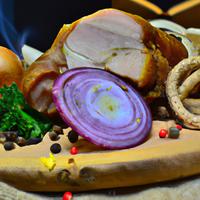
1 serving (100 grams) contains 250 calories, 17.0 grams of protein, 20.0 grams of fat, and 0.0 grams of carbohydrates.

Log this food in SnapCalorie

Nutrition Information
Calories |
595.2 | ||
|---|---|---|---|
% Daily Value* |
|||
| Total Fat | 47.6 g | 61% | |
| Saturated Fat | 16.7 g | 83% | |
| Polyunsaturated Fat | 0 g | ||
| Cholesterol | 166.7 mg | 55% | |
| Sodium | 166.7 mg | 7% | |
| Total Carbohydrates | 0 g | 0% | |
| Dietary Fiber | 0 g | 0% | |
| Sugars | 0 g | ||
| protein | 40.5 g | 81% | |
| Vitamin D | 0 mcg | 0% | |
| Calcium | 23.8 mg | 1% | |
| Iron | 3.6 mg | 20% | |
| Potassium | 714.3 mg | 15% | |
* Percent Daily Values are based on a 2,000 calorie diet. Your daily values may be higher or lower depending on your calorie needs.
Food Attributes
Source of Calories
About Hog
Hog, commonly referring to pork sourced from domesticated swine, is a versatile protein staple widely used across global cuisines, including American barbecue, Chinese stir-fry, and European charcuterie. Nutritionally, pork is rich in high-quality protein, essential vitamins like B12, and minerals such as zinc and iron, which contribute to muscle repair, immune support, and energy production. Cuts like tenderloin and loin are leaner, making them healthier choices compared to fattier options like bacon or ribs. While pork has beneficial nutrients, fattier cuts are higher in saturated fat, which should be moderated to support heart health. Processing methods, such as curing or smoking, can introduce added sodium and other preservatives, reducing nutritional value. Choosing fresh, minimally processed pork and trimming excess fat ensures a balanced approach to enjoying the flavors and nourishment hog offers. It remains a key ingredient in diverse culinary traditions with careful preparation.



